In our view, navigating moderation takes preparation, a mental shift and thoughtful risk management. Diverging monetary policies globally, shifting winds in inflation and meeting market expectations around earnings require consideration. With these potential headwinds in mind, we continue to warn against market timing or making narrow “bets.” In today’s environment, where uncertainty is higher, dispersion of outcomes is wider and timing is as important as ever, we believe a thoughtful long-term approach remains the best recipe for success. In our view, the following topics will help provide a framework for how to approach markets in 2022.
From Pandemic to Endemic
The 1918 Great Influenza wreaked havoc around the world and upended the lives of millions of people. Over 100 years later, variations and mutations of that distant virus are still present in the modern flu.
The hopes for fully eradicating COVID have faded and the reality is COVID seems likely to be a secular virus, not a transitory one. This shift in mentality has several implications for investors. Market volatility around current and future unknown variants should be expected and the disparity among the winners and losers in such bouts may be wider than it has been in the past.
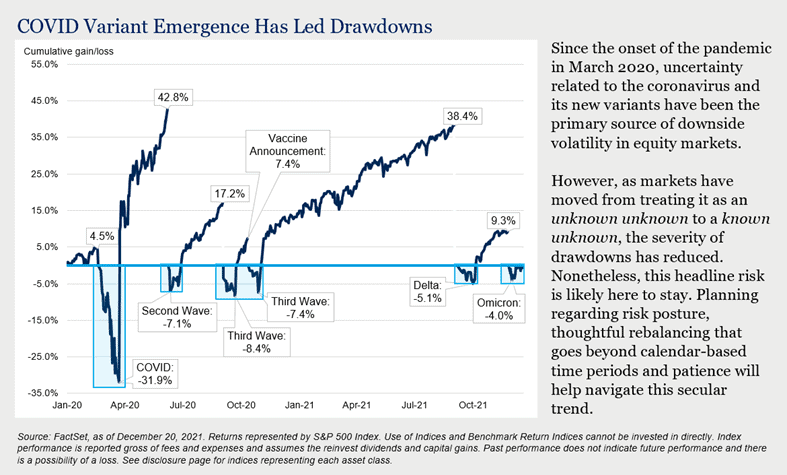
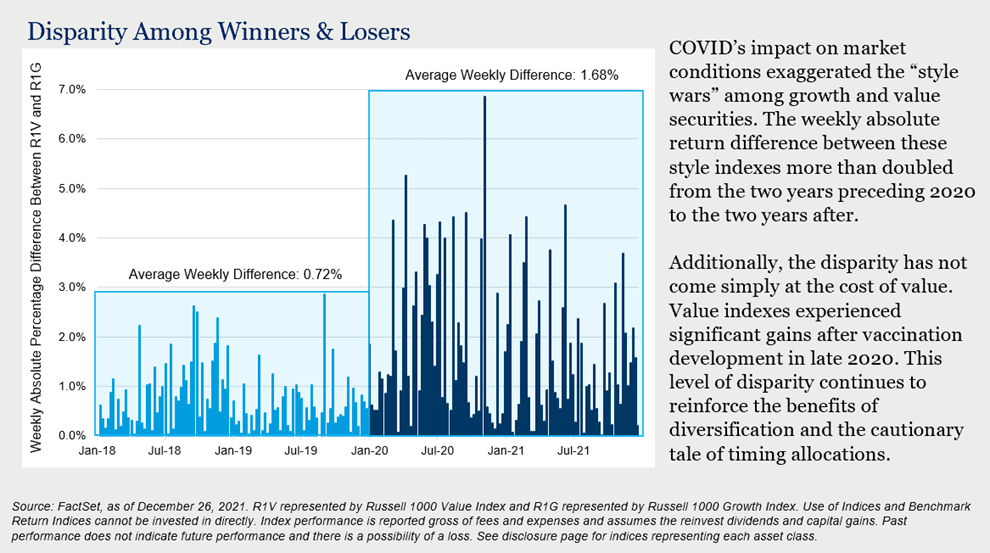
Portfolio Impact
Headline risk is here to stay. Thoughtfully assessing risk posture ahead of future events can help avoid costly emotional decisions during bouts of volatility. Additionally, given the disparity of winners and losers in a volatile environment, diversification matters as much now as it ever has before. Finally, a more active approach to rebalancing may be warranted. It is unlikely COVID-induced volatility will fit neatly in a calendar year or quarterly cycle. Plan ahead to take advantage.
Policy Maker Tightrope
The U.S. Federal Reserve recently acknowledged the persistence of inflation with the majority of FOMC members now expecting to raise the Federal Funds rate three times in 2022[1]. In fact, to combat higher inflation, 38 central banks globally already raised rates in 2021[2]. However, the era of global coordination among banks is beginning to fade as policy makers evaluate economic growth and price stability in their markets. Recently the European Central Bank said it is unlikely to raise rates in 2022 but will modify its bond buying program[3] while the People’s Bank of China cut rates and injected liquidity into the system in response to slowing growth and market volatility after recent regulation changes. These crosscurrents provide both opportunities and challenges for investors looking ahead.
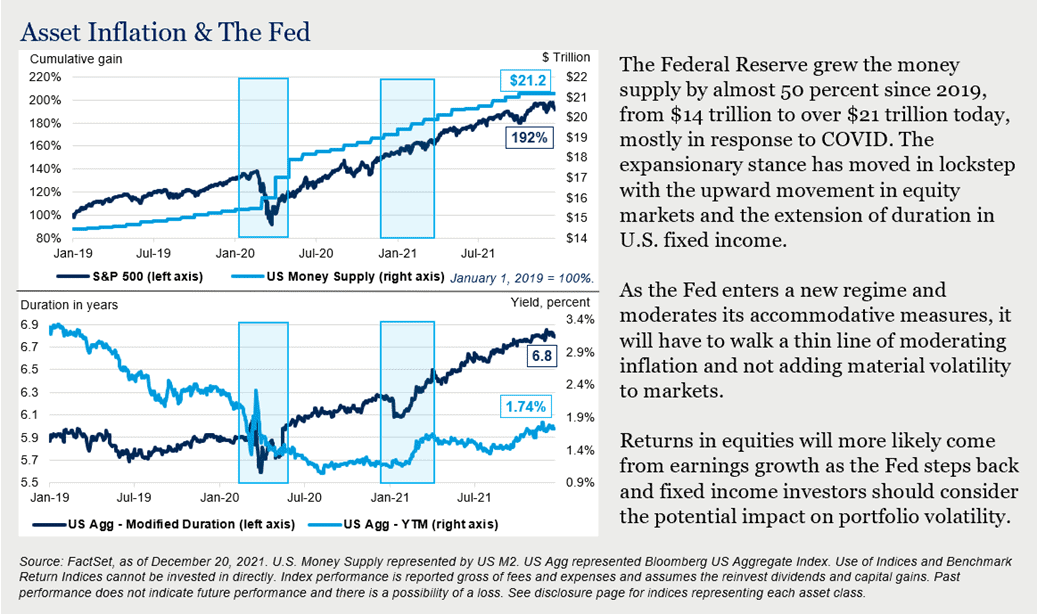
Portfolio Impact
Diverging inflationary dynamics and monetary policies between countries have implications across asset classes. We believe this environment is attractive for active fixed income management, providing a greater opportunity to add value. Additionally, management of interest rate risk is prudent in such a macro-environment.
Within equities, we believe maintaining an allocation to Emerging Markets is warranted, particularly on the heels of Chinese market volatility. Increasing regulatory oversight appears to be reflected in the recent market pullback and stimulus measures from the People’s Bank of China provide near-term support. There may be opportunity ahead.
Inflation: Coming or Going?
The Consumer Price Index (CPI) rose 6.8 percent year-over-year as of October 31, 2021 – the largest increase since 1982[1]. Inflation was initially attributed to the proverbial doors swinging open after shelter in place orders while heightened demand pushed prices higher. Demand remains high with consumer net worth at an all-time high[1] and wages rising[2], but the story moves beyond just the buyer. Supply chain disruptions and fragility, rising energy prices and housing demand all support an environment for above average inflation compared to the most recent two decades.
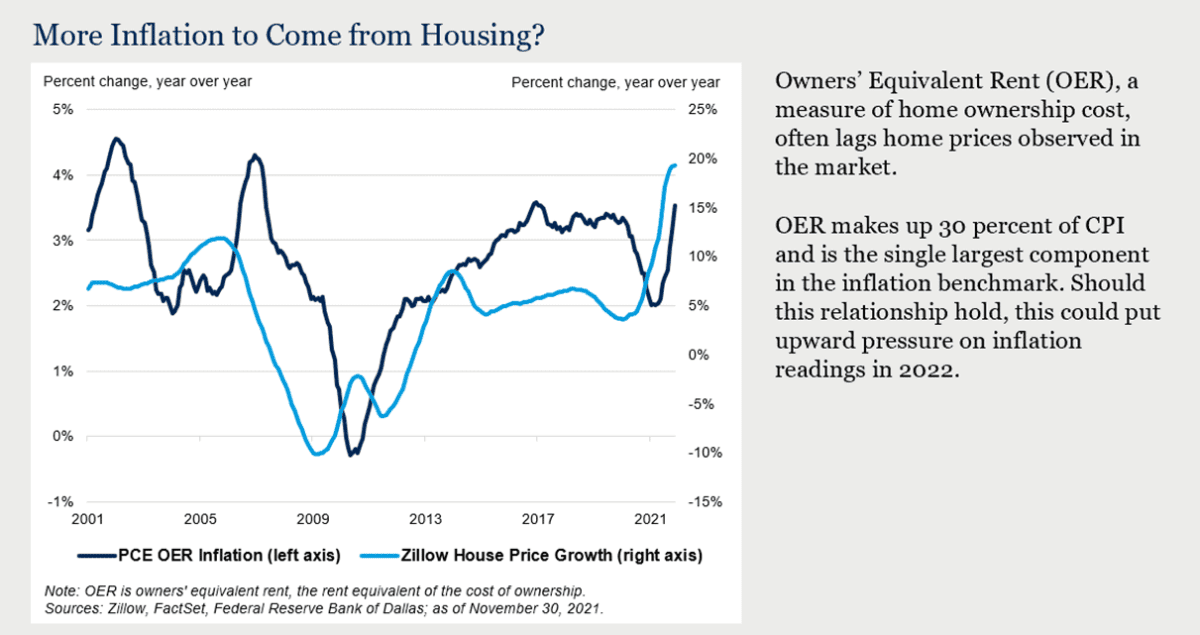
Portfolio Impact
Inflation can and does take many forms. In 2021, inflation was led by rising energy prices, supply chain issues and shortages. Inflation in 2022 and beyond is likely to see these factors subside, but only to be supplanted by persistent recent changes like rising wages and the cost of housing. As a result, inflation-related assets may be impacted in a number of different ways. We believe broadening exposure to real assets can help guard against the shifting tides and sources of inflation and help maintain long-term purchasing power of portfolios while diversifying away from equity risks.
Volatility Ahead: Be comfortable with your risk posture
Domestic equities reached 71 new all-time highs in 2021[7] supported by accommodative monetary policy, a 43 percent earnings increase year-over-year[8] and investors fleeing negative real yields in fixed income as inflation kicked into high gear. However, the steady ascent of equity markets masked the churn beneath the surface. 92 percent of S&P 500 companies experienced a draw-down of at least 10 percent in 2021[9] and the “style-war” between value and growth continued to rage as investors weighed economic re-opening with emerging COVID variants. As we look to 2022, conditions do not appear as favorable for a steady ascent.
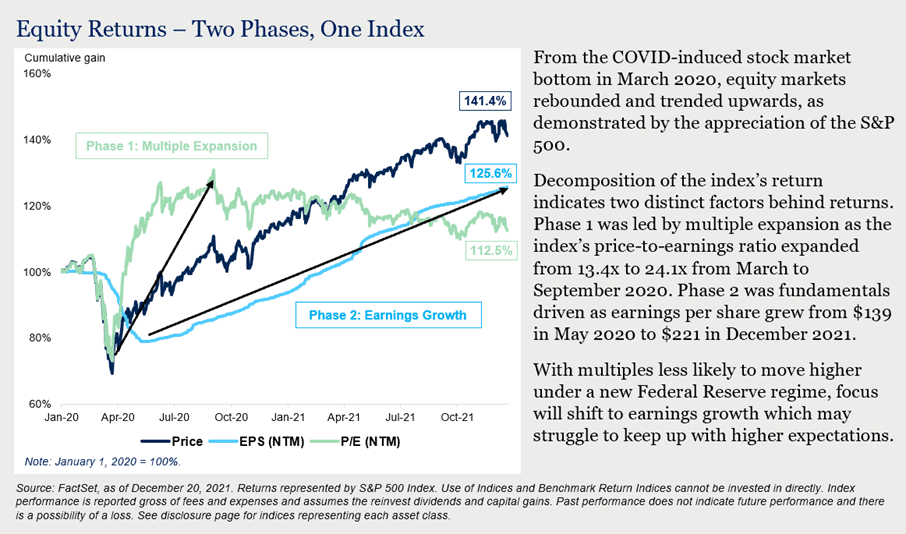
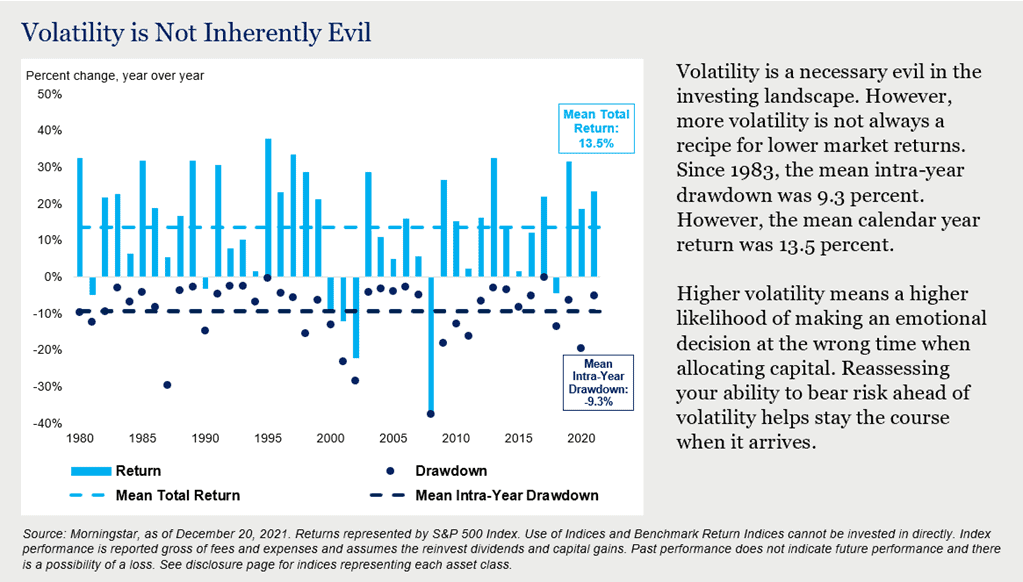
Portfolio Impact
Increasing allocations to U.S. equities, diversifying away from concentrated interest rate risks present in fixed income indexes and further distributing allocations across real assets can help guard against the potential for higher volatility across global markets and the numerous ways in which it can manifest.
However, we continue to remind investors that timing markets rarely proves to be a successful investment strategy. Rather, understanding your ability to bear risk and thoughtfully managing risk exposures can lead to more persistent success over time.
Final Thoughts
Diverging global monetary policies, changing winds in inflation and meeting market expectations around earnings are likely to impact asset classes. However, navigating a shifting landscape and the potential for greater volatility is not a new task for investors. For 2022, we believe the right mental approach to COVID curveballs, managing fixed income risks in a dynamic environment, fine tuning global equity allocations and broadening inflation related assets to guard against decay will put investors one step closer to achieving their long-term goals.
For more information, please contact any of the professionals at MPS LORIA Financial Planners, LLC.
Disclosures and Index Proxies
This report does not represent a specific investment recommendation. Comparisons to any indices referenced herein are for illustrative purposes only and are not meant to imply that actual returns or volatility will be similar to the indices. Indices cannot be invested in directly. Unmanaged index returns assume reinvestment of any and all distributions and are reported gross of any fees and expenses. Any forecasts represent future expectations and actual returns; volatilities and correlations will differ from forecasts.
When referencing asset class returns or statistics, the following indices are used to represent those asset classes, unless otherwise notes. Each index is unmanaged, and investors can not actually invest directly into an index:
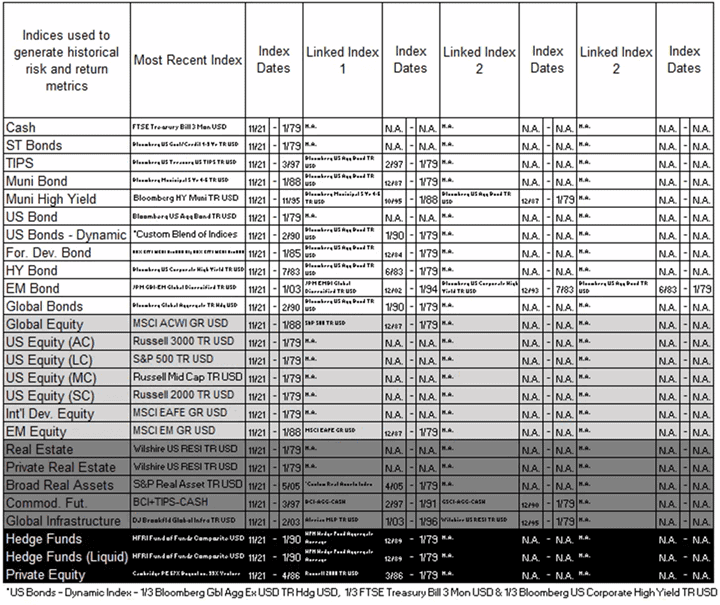
- The S&P 500 is a capitalization-weighted index designed to measure performance of the broad domestic economy through changes in the aggregate market value of 500 stocks representing all major industries.
- Russell 1000 Growth measures the performance of those Russell 1000 companies with higher P/B ratios and higher forecasted growth values.
- Russell 1000 Value measures the performance of those Russell 1000 companies with lower P/B ratios and lower forecasted growth values.
- Consumer Price Index is a measure of prices paid by consumers for a market basket of consumer goods and services. The yearly (or monthly) growth rates represent the inflation rate.
| All advice is offered through: MPS LORIA Financial Planners, LLC, a registered investment advisory firm. Securities offered through: LORIA Financial Group, LLC, a registered broker dealer; member FINRA & SIPC. Please read all investment material carefully before any investing. It is important to consider all objectives, risks, costs and liquidity needs before investing. Please contact an investment professional for a copy of any investment’s most recent prospectus. MPS LORIA Financial Planners, LLC and LORIA Financial Group, LLC do not provide tax or legal advice. All information provided is for informational purposes and it is at the sole discretion of the client on how or if they proceed with any implementation of such information. As it pertains to tax or legal topics the client must discuss with their CPA or attorney before proceeding. MPS LORIA Financial Planners, LLC nor any of its affiliates, members, directors or employees can be held responsible for use of information provided. While reasonable efforts are made, information provided is not guaranteed to be accurate. This report is intended for the exclusive use of clients or prospective clients of MPS LORIA Financial Planners, L.L.C. Content is privileged and confidential. Dissemination or distribution is strictly prohibited. |
